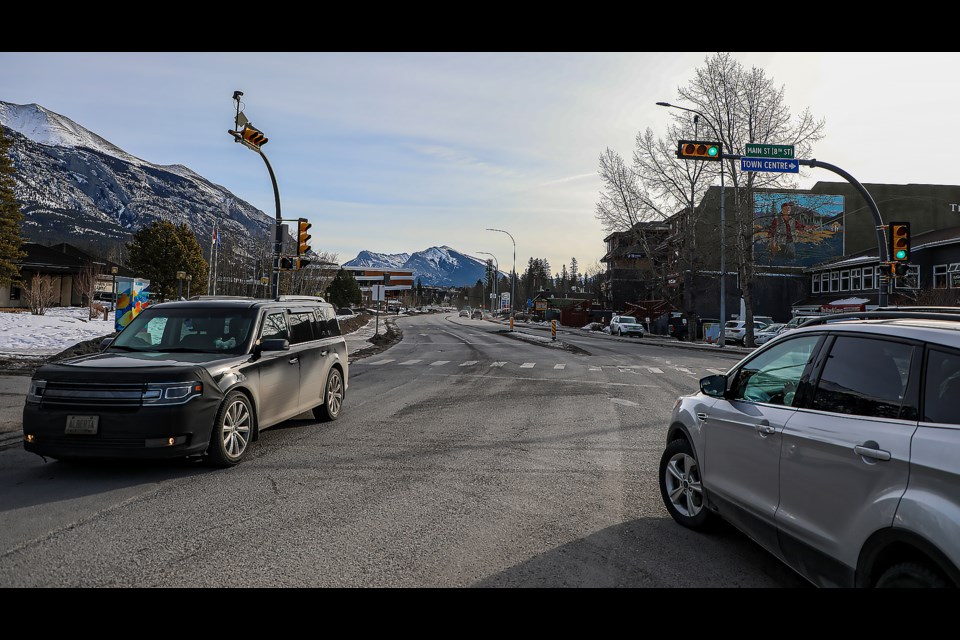CANMORE – A revamped Intersection 2.0 and 3.0 modelled after the one on Bow Valley Trail, Benchlands Trail and Railway Avenue could soon be coming to Canmore.
In a presentation to council at the Tuesday (Jan. 17) committee of the whole meeting, Town staff showed a potential update to the conceptual design for work on a stretch of Railway Avenue between 10th Street and Bow Valley Trail could see construction begin as early as 2024.
The work, if approved by council, is among the ongoing projects to help with mode shift efforts by the municipality.
“Unless we continue to build this infrastructure, we won’t see the changes that are happening,” said Adam Robertson, the Town’s communications advisor. “Every project will become slightly easier because we have stats to show, we can point to what’s happening, there’s more understanding to what near sight signals will look like.
“It’s going to be a challenging conversation. … We can show all the stats we want and previous information, but we just need to continue putting these projects in the community and the community will understand them more.”
If approved and once completed, the street is expected to be able to handle beyond 18,000 vehicles a day – above the average of 14,000 now with a peak of 17,000 – with a single lane in either direction and turns at certain spots. A two-lane stretch would be maintained near the railway tracks to help when trains cause traffic stops.
If the Town’s mode shift goals are achieved, by 2030 it’s expected the stretch of road would see about 13,900 vehicles a day.
The mode shift goals are to allow for more transit options such as walking and cycling to have 40 per cent non-vehicle traffic at peak times rather than personal vehicles. It would also have separated protected lanes similar to the one on Bow Valley Trail, Benchlands Trail and Railway Avenue.
“Transportation projects tend to provide you with a travel time improvement initially. The difference here is there’s an additional travel time initially in order to prevent a much larger change in travel time down the road,” said Andy Esarte, the Town’s manager of engineering. “If we work strictly to improve vehicle travel time today, what we’d end up seeing is that benefit would vanish pretty quickly and we’d be back to where we are. It’s a long-term investment.”
Online engagement will take place Jan. 23 to Feb. 10 and an open house will happen Jan. 25 at the Canmore Recreation Centre from 5:30-7:30 p.m. in addition to online feedback. Town staff is anticipated to return to council for approval in the spring.
While the new intersection was often the frustration of residents and visitors during construction and its first months of operation, it provides separated and wider lanes for pedestrians and cyclists.
The eventual installation of the signal controller – which was delayed due to supply issues – and helped learn vehicle patterns has aided in adapting to traffic volumes and flows to assist with the moving of vehicles.
Esarte said statistics show more people are cycling and walking through the intersection – a daily average of 4,000 in the summer – while a slight increase in vehicle volume has taken place.
The concept design was originally presented to the previous council in 2019 and was the basis for the Transportation Improvement Program in 2020. It came after the Integrated Transportation Plan was passed in 2018.
Council approved the Railway Avenue south transit corridor project in 2019, which included the intersection at Bow Valley and Benchland trails and Railway Avenue.
Mayor Sean Krausert said he’s a “huge fan” of the new intersection and a mistake he made as a councillor was not understanding why widening transit corridors such as what took place in Spring Creek Mountain Village allowed for other transit options such as walking and cycling to be safer viable options.
“If you go into Spring Creek now… there’s so much room for cyclists and walking than the actual driving portion … You can’t really go fast. It’s designed to keep you slow,” he said.
Coun. Joanna McCallum echoed Krausert’s thoughts and highlighted it’s a common feature in parts of Europe and a key aspect is having people adjust what they’ve been used to when it comes to moving traffic.
“I think what we’re used to in North America is the primacy of the single-passenger vehicle and we need to think more about the sharing of our transportation network among different modes,” she said. “If we provide a safer environment then more people will want to walk, more people will want to get on their bikes and consider that.”
The previous council cancelled a street improvement design for Railway Avenue in May, 2020 to minimize the impacts of the COVID-19 pandemic. Council approved $500,000 to complete the street improvements of Railway Avenue designed at the 2022 budget.
The Railway Avenue north project – the third phase – would see construction on the intersections at Bow Valley Trail and 17th Street and street improvements.
According to the staff report, a central median was in the original plan but was scaled back to allow more left-hand turns.
Esarte noted Town staff have learned from the first phase of the project, which he called “challenging”, but the positive results in mode shifting and increased safety have taken place with “exposure for vulnerable road users limited and minimized at all times.”
He said near sight lights see vehicles stop further back, providing additional safety to cyclists and pedestrians and the widening of those lanes allow such traffic to move.
“We’re building streets for efficient operation, but we’re building a transportation system to move people,” Esarte said. “The changes here allow for the capacity for people who want to and need to drive, but it’s about building it in a way that matches our community in terms of how we want to and need to move people.”




